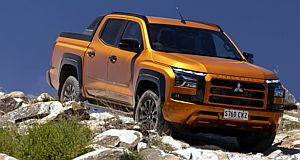
Overview
The all-new Mitsubishi Triton has made its debut in Australian showrooms, featuring a fresh design, significant upgrades to its chassis and mechanics, advanced technology, and enhanced safety features.
This sixth-generation model represents a significant milestone for Mitsubishi, especially as consumers in the light commercial vehicle segment seek more value without compromising performance.
Prices have seen an increase of up to 15%, with the Triton now starting at $43,690 plus on-road costs for the dual-cab variant. Club and single-cab versions will be available later, along with two-wheel drive models featuring lower-performing engines.
This review will focus on the highly specified, dual-cab, four-wheel drive, automatic Triton grades equipped with Mitsubishi’s upgraded 2.4-liter twin-turbo-diesel engine. The engine now delivers a competitive 150kW and 470Nm, a significant improvement over its predecessor.
The Triton’s fuel efficiency has also improved, with the range consuming as little as 7.5 liters per 100km in 4×2 format and 7.7 liters per 100km in 4×4 configuration. Additionally, an AdBlue tank will need periodic refills.
The larger Triton now boasts a higher braked towing capacity of 3500kg, matching its class rivals.
Mitsubishi has aimed to position the Triton as a premium option in its class, offering generous standard equipment across the GLX, GLX+, GLS, and GSR lineup. Highlights include digital instrument panels, touchscreen infotainment systems with Apple CarPlay and Android Auto connectivity, and various safety features like forward collision mitigation and driver monitoring systems.
On the road, the Triton demonstrates significant improvements in driving dynamics and cabin refinement. The cabin is quieter, more spacious, and better finished than its predecessor, offering a comfortable driving experience.
The steering is sharper and more direct, providing better feedback and road feel. The Triton’s chassis has also been enhanced for improved stability and cornering performance.
Off-road, the Triton impresses with its Super Select II four-wheel drive system, providing excellent control in various conditions.
While Triton excels in many areas, there are some areas for improvement. Visibility can be challenging due to the vehicle’s longer bonnet and thick A-pillars, while the driver attention monitor may need recalibration.
Overall, the all-new Mitsubishi Triton offers excellent value for money and deserves consideration for buyers seeking a capable and reliable utility vehicle.

